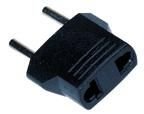Moving from 110V to 220V Electronics: Transformers, Adapters, Power Strips-Oh My!
When we were first moving abroad from the US, I learned there would be a thing or two to figure out when it comes to electrical systems and I put it off till the very last second. Why? Because let’s face it: it’s boring and for those of us who skipped physics classes in high school, very confusing.
After my trials and tribulations, I’m now writing this with the hopes that my guide can be helpful to those of you who are moving abroad and navigating countries with differing electrical systems. A little background: in North America, most of our electronics are 110 volts (110V). In Ethiopia —and the majority of other countries as I’ve come to learn—220-240V reigns. Check the map below if you’re unsure what electrical systems are used in the country you’re moving from and to. If you’re staying within the same voltage system, consider yourself lucky and click the little X on the corner to exit from reading the rest of this post. Next week, we’ll be talking about Expat Living in Addis and religious celebrations. Tune in then for more valuable content.
If, however, you’re moving from a country that uses one voltage system to one that uses another, then this is for you my friend.
The different gadgets and when to use them
Use a voltage transformer if…
…you want to use your TV, iron, flat iron, clothes iron, clothes steamer, table lamps, blow-dryer, etc. (basically any device with a heating element or a mechanical motor) in a country that uses a different voltage system. A step up/step down transformer with a built-in regulator is best. You can also use a converter for certain appliances, but I didn’t choose to go with converters in my case because those cannot be continuously used (only an hour or two at best.)
So what is a transformer and what does it do? It is a machine that literally increases or decreases the voltage, making it compatible for use where you are. Practically, this means that you can plug your electronics on one side to step-up the voltage (so from 110V to 220V) or on the other side to step it down (from 220V to 110V.)
A voltage transformer is basically a box that looks like like the picture above. I got mine from this site, which ships in the US. They’re not cheap, but two or three of these throughout the house should be plenty. The benefit of getting one with a built-in regulator is that if there’s ever a surge, the regulator built into the transformer will protect your electronics from burning out. Make sure the transformer you buy has a built-in regulator cause nobody likes to see their TV fizzle and pop. :) On the site I mentioned above, you can see several different types of converters with varying wattages at different price points. Wattage? Why’s that important? Well, an iron will need a transformer with much less power rating than, say, a microwave. You need to make sure the transformer’s power rating (aka wattage) is at least 10% greater than that of the device. All to say, it depends on what the transformer you will be buying will be used for. Is it for a huge 75’ TV? For your blow dryer and flat iron? Before getting a transformer, I advice you consider what it’ll be used for, and look for the input which is usually found on the device you’ll be using with the transformer. You can do your research and buy a transformer at the appropriate wattage to ensure you’re not overspending money.
2. Use an adapter if…
…you just need to plug your 110/220V electronics into a local electric wall socket. When do you use an adapter versus a transformer as mentioned above? Good question. You’d use an adapter for most laptops, cell phones, tablets, and any electronics that indicate 110/220V on them. Note: if you throw on an adapter and plug in your table lamps, your blow dryers, (or any of the items I mentioned in #1) into the wall, it will crack, fizzle, and pop. I repeat, do not plug any of the shit mentioned above in point #1 into an adapter and plug directly into the wall. You need a voltage transformer. If you don’t want to deal with the hassle of buying a voltage transformer, I’d recommend either A) selling your electrical devices that use heat/motor mentioned in #1 and buying new ones locally once you move or B) if you have the option to ship items, selling and buying new ones on 220-electronics.com.
3. Use power strips if…
…you don’t want to get a bunch of adapters and want to consolidate where you plug in your electronics per room. I use a power strip like the one mentioned above to plug in my cell phone, laptop, and tablet. Note: a power strip is not the same thing as a voltage transformer, even if it says it has a circuit breaker reset switch. I learned this the hard way when I plugged in not one but both my nightstand table lamps into a power strip, brushed my teeth, got comfy in bed with my good book, turned on my lamps, and *POOF* they both bursted. If the item is not dual 110/220V, you still need to plug it into a voltage transformer or a converter (which is another gadget I don’t cover here, because it basically does the same work as a transformer for less time, hence I didn’t get any.)
Someone recently asked me, “can I plug my power strip into a transformer and use a bunch of devices on it at once?” The answer is, I’m entirely unsure. Ask someone else (and have a fire extinguisher handy if you decide to try it.) I haven’t dared, and I probably never will!




